When your kidneys aren't working right, fluid doesn't just disappear-it builds up. That’s edema. Swollen ankles, puffy eyes, a tight belly. It’s not just uncomfortable; it’s a warning sign your body is drowning in its own fluids. For people with chronic kidney disease (CKD), this isn’t rare. It’s common. And if left unchecked, it can land you in the hospital-or worse.
Why Edema Happens in CKD
Your kidneys filter about 120-150 quarts of blood every day. They pull out waste and extra water, sending it out as urine. But when kidney function drops-say, below 60 mL/min/1.73m²-you start losing that ability. Sodium sticks around. Water follows sodium. And before you know it, fluid leaks out of your blood vessels and pools in your tissues. This isn’t just about drinking too much water. It’s about your kidneys failing to tell your body when to let go. The result? Swelling in your legs, feet, hands, and sometimes even your lungs or belly. In advanced stages (CKD stages 4 and 5), this becomes a daily battle.Diuretics: The Fast Fix with Hidden Risks
Doctors reach for diuretics first. They’re the quickest way to flush out the extra fluid. But not all diuretics are the same-and choosing the wrong one can hurt more than help. For people with eGFR under 30, loop diuretics like furosemide (Lasix), bumetanide, or torsemide are the go-to. They work on the thick ascending limb of the loop of Henle, where most sodium gets reabsorbed. A typical starting dose? 40-80 mg of furosemide daily. If that doesn’t work, doses can go up to 160-320 mg. But here’s the catch: higher doses don’t always mean better results. In fact, when daily furosemide hits over 160 mg in stage 4 CKD, the risk of sudden kidney injury jumps 4.1 times. For those with better kidney function (eGFR above 30), thiazides like hydrochlorothiazide can still work. But here’s where things get interesting: combining a loop diuretic with a thiazide-called sequential nephron blockade-can double the fluid loss. It’s powerful. But it also raises the risk of acute kidney injury by 23%, according to an NIH study of over 300 non-dialysis CKD patients. And then there’s spironolactone. It’s not a typical diuretic. It blocks aldosterone, which reduces sodium retention and helps with fluid buildup, especially in people with heart failure or cirrhosis. But in late-stage CKD, it can spike potassium levels dangerously high. More than 25% of patients with stage 4 or 5 CKD develop hyperkalemia on this drug. That’s why it’s used carefully-only when the benefits clearly outweigh the risks. The FDA’s March 2025 approval of IV furosemide for CKD patients with eGFR under 15 is a game-changer. Oral pills don’t absorb well when kidneys are failing. IV delivery bypasses that problem, clearing 38% more fluid than pills in severe cases. But it’s not a magic bullet. It still carries the same risks: low blood pressure, dehydration, and kidney damage if pushed too hard.Salt Restriction: The Most Powerful Tool You’re Probably Ignoring
Here’s the truth: no diuretic works well if you keep eating salt like it’s going out of style. The National Kidney Foundation’s KDOQI guidelines say: no more than 2,000 mg of sodium per day. That’s about 5 grams of table salt. For advanced CKD, they recommend 1,500 mg. Sounds simple. But 75% of the sodium we eat comes from packaged and restaurant food-not the salt shaker. Think about this: two slices of bread? 300-400 mg sodium. One cup of canned soup? 800-1,200 mg. Two ounces of deli meat? 500-700 mg. Add a bag of chips, a jar of pickles, and a frozen dinner, and you’ve hit your daily limit before lunch. Strictly sticking to 2,000 mg a day can reduce swelling by 30-40% in early-stage CKD-without any pills. That’s not a guess. That’s from the American Kidney Fund’s patient data. But doing it? That’s the hard part. Most people don’t know how to read labels. They think “low sodium” means no sodium. It doesn’t. “Reduced sodium” still has plenty. And hidden sources? Yogurt (200 mL fluid per cup), soups, sauces, even some medications. Fluid intake matters too. In late-stage CKD, limiting total fluids to 1,500-2,000 mL a day is often necessary. That includes everything you drink, plus the water in your food. Real success means working with a renal dietitian. Three to four sessions on label reading, cooking without salt, and finding alternatives can make all the difference. Without that support, most people give up within weeks.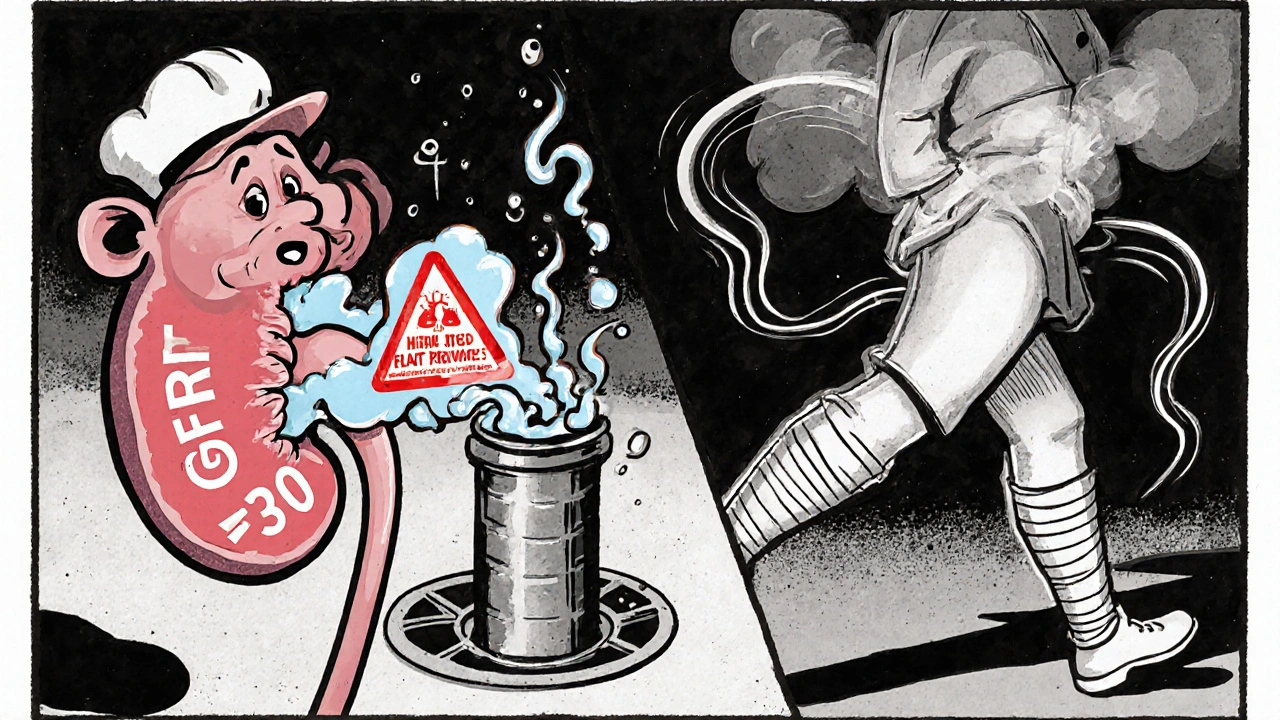
Compression Therapy: When Your Legs Won’t Stop Swelling
Diuretics and salt control help the whole body. But if your legs are swollen, you need something that targets them directly. Graduated compression stockings (30-40 mmHg at the ankle) are the gold standard. They squeeze your legs from the bottom up, pushing fluid back toward your heart. Studies show they reduce leg volume by 15-20% in just four weeks. But here’s the problem: only 38% of people keep wearing them after three months. Why? They’re hard to put on. They itch. They feel tight. Some people get skin sores. Others just don’t believe they work. The fix? Combine them with movement. Walking 30 minutes five days a week improves edema control by 22% compared to sitting still. Elevating your legs above heart level for 20-30 minutes a few times a day helps too-reducing swelling by 25-30%. For severe cases-especially with nephrotic syndrome-intermittent pneumatic compression devices are an option. These machines inflate and deflate around your legs in cycles, mimicking muscle movement. One study found they reduced leg circumference 35% more than regular stockings alone. But none of this works if you don’t do it consistently. That’s why physical therapists are now part of the CKD care team-not just for rehab, but for daily fluid management.The Bigger Picture: Balancing Risk and Relief
There’s a tension in treating edema in CKD. On one side, untreated fluid overload increases your risk of heart failure, hospitalization, and death by 28%. On the other, aggressive diuretic use can cause kidney damage, low blood pressure, and electrolyte chaos. Dr. David Wheeler from KDIGO says it plainly: “The therapeutic window is narrow.” Push too hard, and you risk acute kidney injury. Don’t push enough, and you risk dying from volume overload. The goal isn’t to eliminate every drop of fluid. It’s to reach “dry weight”-the lightest weight you can safely maintain without swelling, dizziness, or shortness of breath. That’s usually a loss of 0.5 to 1.0 kg per day in acute cases. Slow and steady wins the race. A 2022 Mayo Clinic study showed that patients who got care from a full team-nephrologist, dietitian, physical therapist-had a 75% success rate controlling edema within eight weeks. Those on standard care? Only 45%.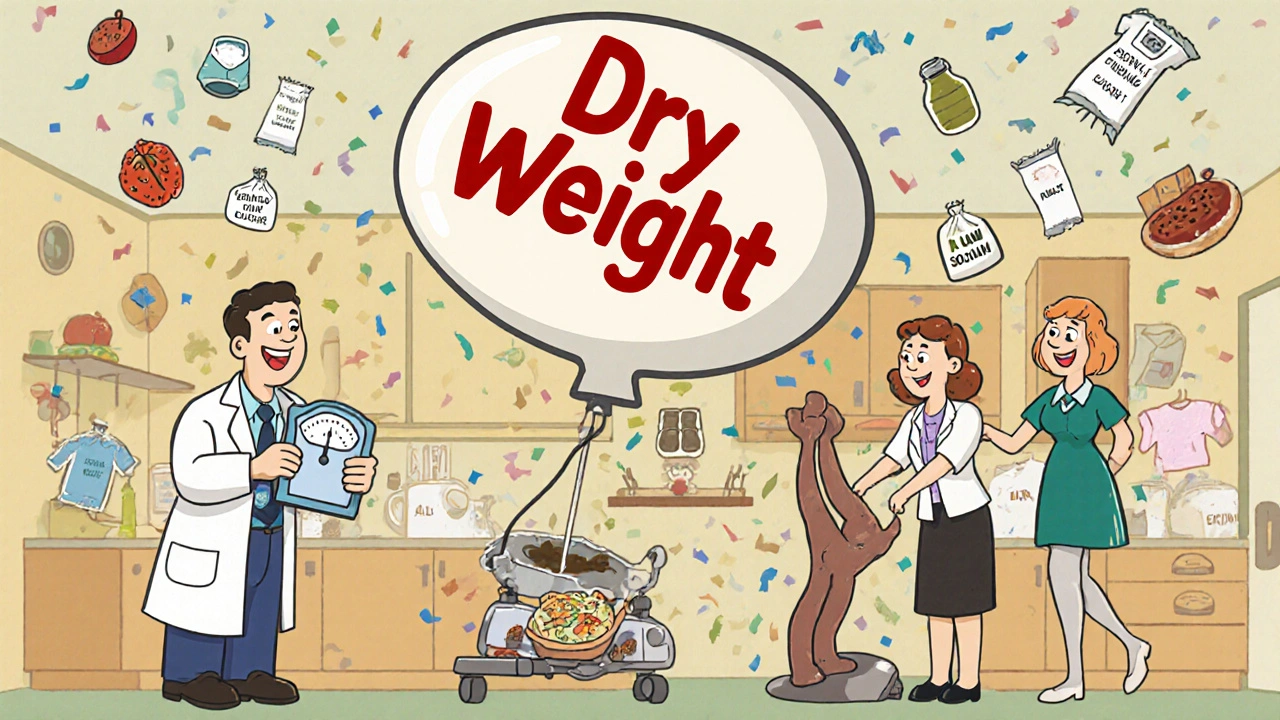
What Works Best? A Real-World Plan
If you’re dealing with edema from CKD, here’s what actually works, based on real data and expert guidelines:- Start with salt. Cut sodium to 2,000 mg/day. Use a food scale and app to track it. Avoid processed foods. Cook at home.
- Limit fluids. If you’re in stage 4 or 5 CKD, aim for 1,500-2,000 mL total daily-including soup, yogurt, fruit, and drinks.
- Use diuretics wisely. Ask your doctor: What’s your eGFR? Are you on a loop diuretic? Is a combination needed? Are you being monitored for potassium and kidney function?
- Wear compression stockings. Get 30-40 mmHg graduated ones. Put them on before you get out of bed. Keep them on all day.
- Move daily. Walk. Stretch. Elevate your legs. Don’t sit for long stretches.
- Get support. Work with a renal dietitian. See a physical therapist. Don’t try to do this alone.
What Not to Do
- Don’t increase your diuretic dose on your own. More isn’t better-it’s dangerous.
- Don’t assume “no salt added” means no sodium. Check the label.
- Don’t skip compression therapy because it’s uncomfortable. The discomfort is temporary. The swelling isn’t.
- Don’t ignore dizziness, cramps, or confusion. These are signs your body is out of balance.
Edema in CKD isn’t a nuisance. It’s a signal. And the best way to respond isn’t with one magic pill or one quick fix. It’s with a smart, steady, team-based approach that respects your kidneys, your body, and your life.
Can I stop taking diuretics if I eat less salt?
Sometimes, yes-but only under medical supervision. In early-stage CKD (stages 1-3), strict sodium restriction can reduce or even eliminate the need for diuretics. But in stages 4 and 5, your kidneys are too damaged to handle fluid balance on their own. Stopping diuretics without a plan can cause rapid fluid buildup, leading to shortness of breath, high blood pressure, or heart strain. Never stop or change your dose without talking to your nephrologist.
Why do my legs swell more at night?
Gravity pulls fluid down throughout the day, especially if you’re standing or sitting. At night, when you lie down, that fluid doesn’t immediately go away-it redistributes. If your kidneys aren’t removing enough sodium, the fluid stays in your tissues. Elevating your legs before bed and wearing compression stockings during the day can help reduce this buildup.
Is drinking more water helpful for edema in CKD?
No. Drinking more water won’t flush out the extra fluid-it just adds to the problem. In CKD, your kidneys can’t make enough urine to keep up. Extra fluid leads to more swelling, higher blood pressure, and strain on your heart. Most patients with advanced CKD are advised to limit total fluid intake to 1,500-2,000 mL per day, including fluids from food.
Can compression stockings make edema worse?
Only if they’re worn incorrectly. Compression stockings should be snug at the ankle and gradually looser toward the knee. If they’re too tight, rolled down, or worn with skin sores, they can restrict blood flow and cause harm. Always get fitted by a professional. If you feel numbness, tingling, or increased pain, stop using them and talk to your doctor.
What foods should I avoid to reduce sodium?
Avoid canned soups, processed meats (bacon, ham, deli slices), frozen meals, soy sauce, pickles, olives, cheese, bread, and restaurant food. Even “healthy” snacks like granola bars and salad dressings can be loaded with sodium. Always check the nutrition label: 200 mg or more per serving is high. Look for “no salt added,” “low sodium,” or “unsalted” versions.
How long does it take to see results from salt restriction?
Most people notice less swelling within 2-4 weeks of cutting sodium to 2,000 mg/day. Weight loss from fluid loss can be 1-2 kg in the first week. But consistency matters. One high-sodium meal can undo days of progress. The key is making low-sodium eating a habit, not a short-term diet.

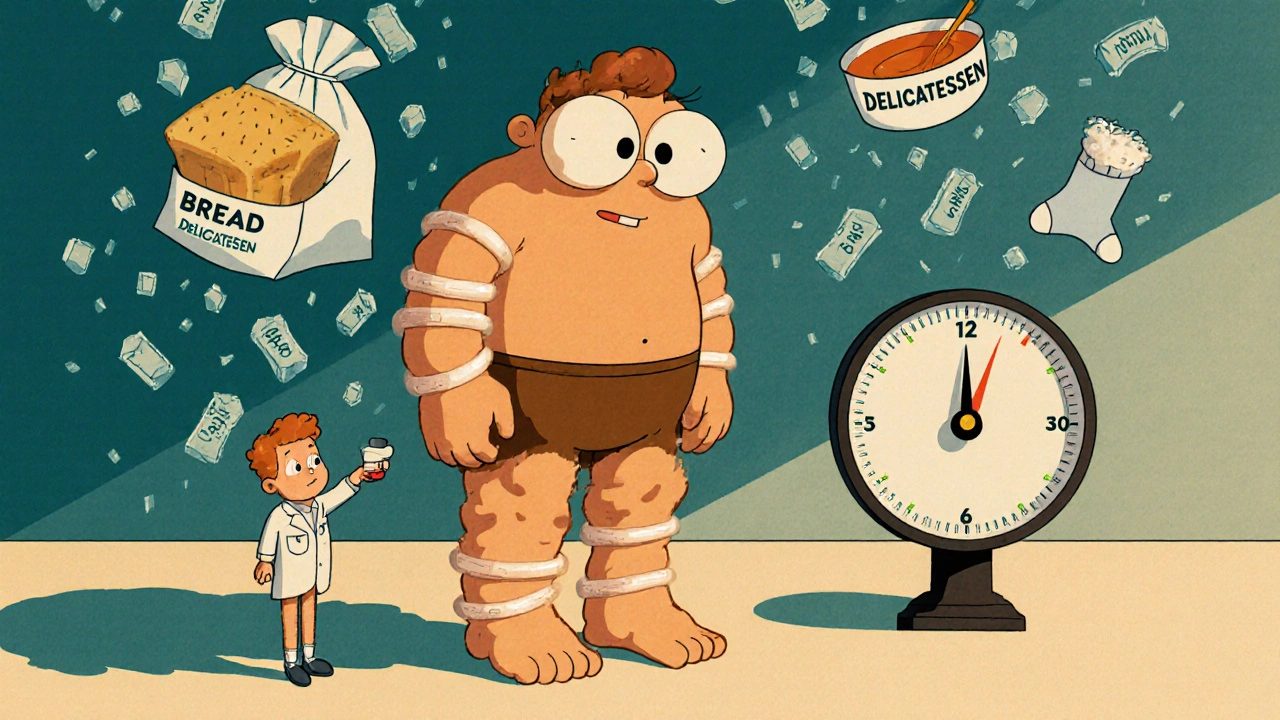

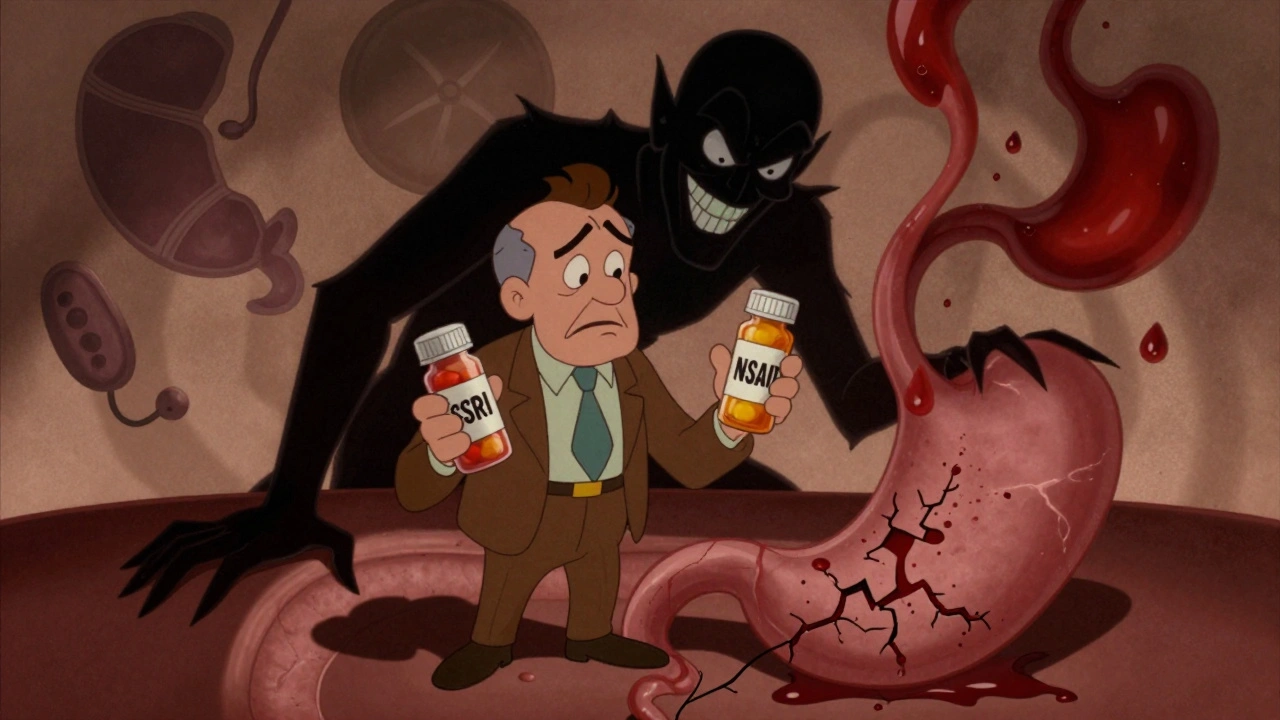
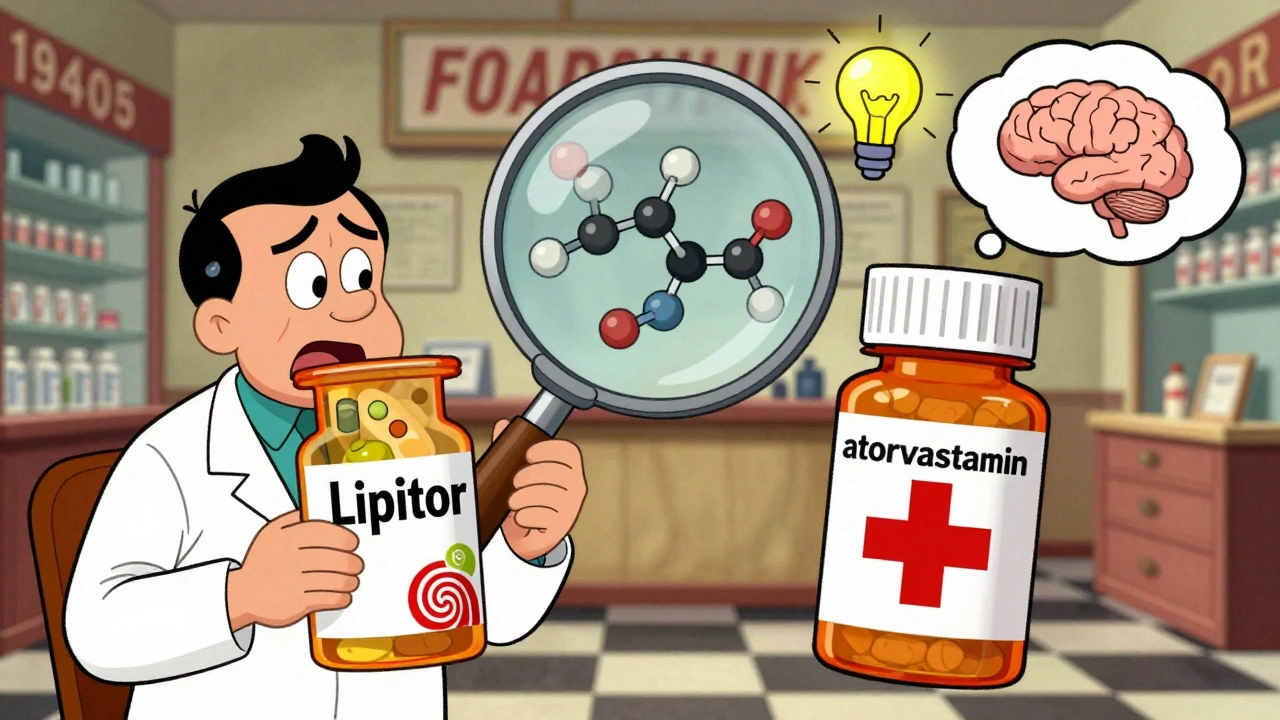
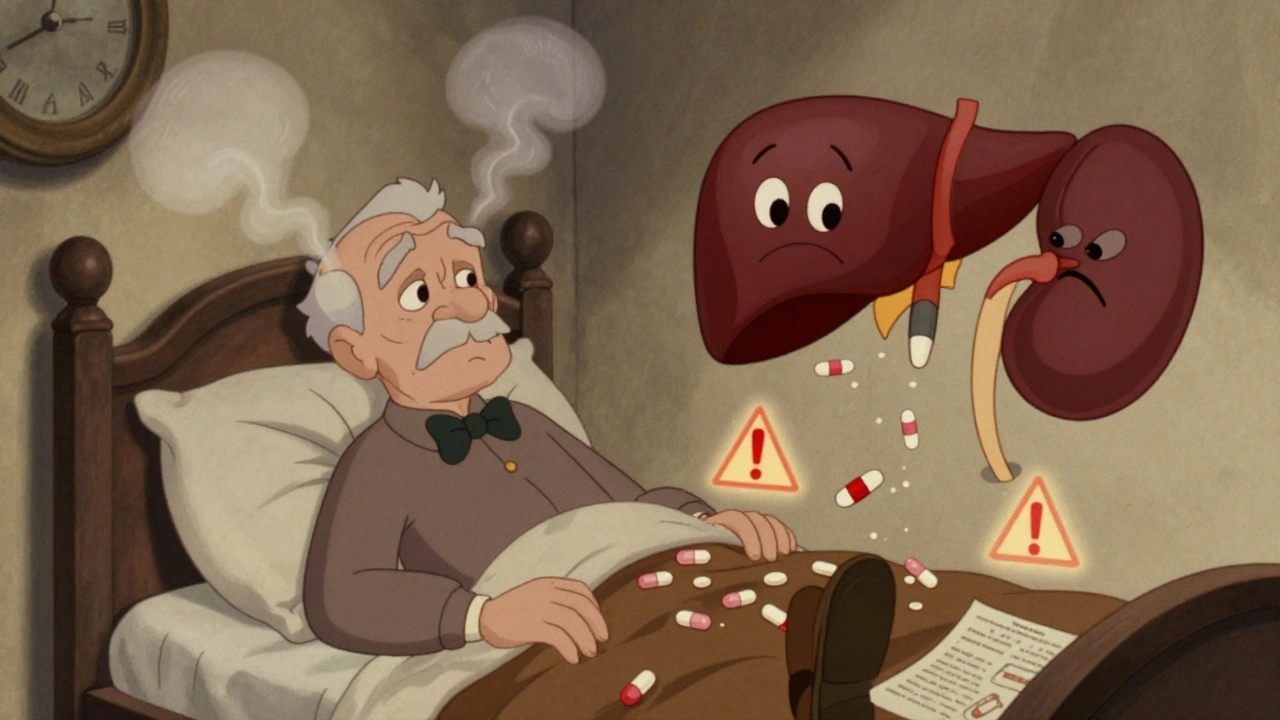
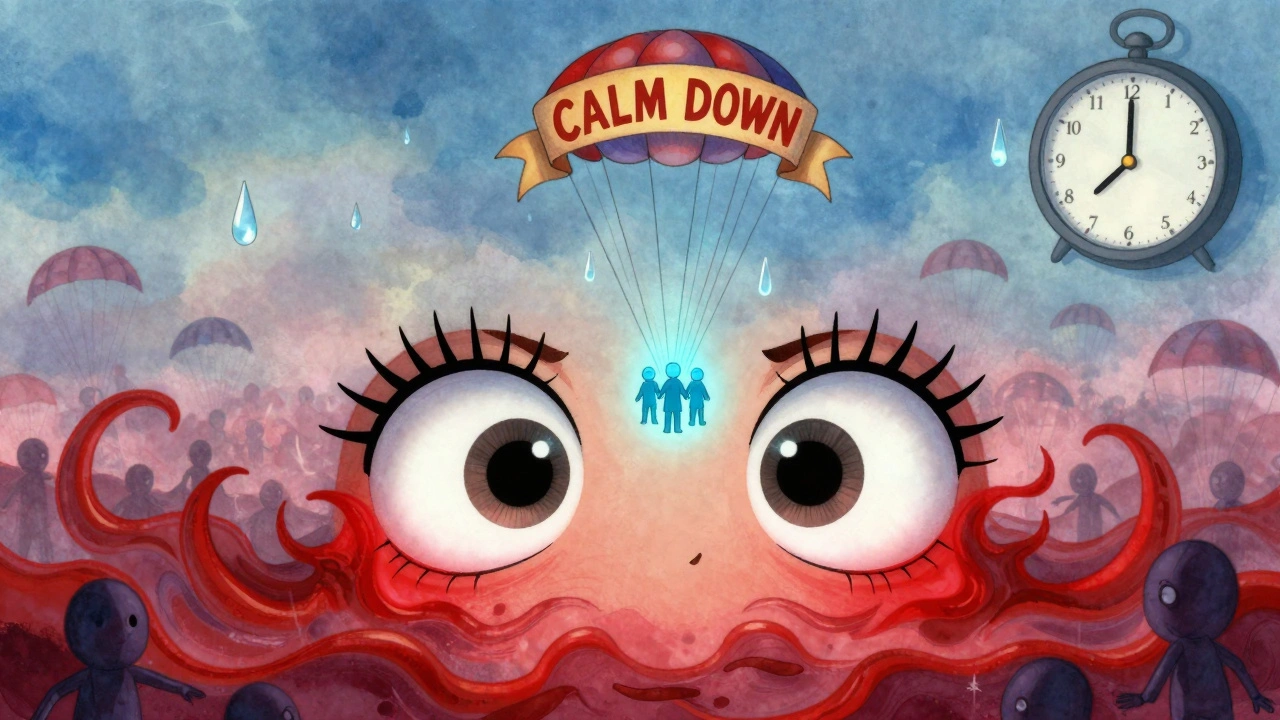
steffi walsh
Y’all need to hear this: salt is the real villain here. I cut mine to 1,500mg and my ankles stopped looking like balloon animals in 10 days. No magic pills, just real food. 🙌
Riohlo (Or Rio) Marie
Oh, so we're now treating edema like it's a bad brunch buffet? 'Oh no, my kidneys are failing, let me just avoid the soy sauce and call it a day.' Please. Diuretics are the only thing keeping half of us alive. You think your kale smoothie is going to replace furosemide? Sweetheart, your 'low-sodium' quinoa bowl has more sodium than my last hospital IV bag. 😘
Conor McNamara
they say salt is bad but what if the salt is laced? i read a forum once where the fda approved iv furosemide but the vials were traced back to a lab in china that also made fake blood pressure meds. i think the whole thing is a pharmaco-control scheme. they want us dependent. watch your back.
Leilani O'Neill
Of course you’re all talking about salt like it’s some kind of moral choice. Real people don’t cook. Real people work two jobs and survive on microwave meals. You think telling someone with stage 4 CKD to ‘read labels’ is helpful? That’s not advice. That’s class warfare dressed as medical guidance. If your kidneys are failing, you shouldn’t have to become a nutritionist to stay alive.
Hal Nicholas
Compression stockings? The same ones they gave my aunt who died in a nursing home? Yeah, no. I’ve seen what happens when you put pressure on compromised limbs. It’s not ‘helping’-it’s just delaying the inevitable. And don’t get me started on ‘walking 30 minutes.’ I can barely stand. You’re not helping. You’re gaslighting.
Louie Amour
Let me stop you right there. You think salt restriction is the answer? Tell that to the 30% of patients who still get pulmonary edema even on zero sodium. The real problem? The FDA. They’re letting Big Pharma push IV furosemide because it’s profitable. Meanwhile, they ignore the real solution: kidney regeneration via stem cells-which Big Pharma doesn’t own the patent for. You’re being played.
Kristina Williams
i heard from my cousin's neighbor's sister who works at a hospital that diuretics make your kidneys forget how to work on their own. so you get hooked. and then they give you more. it's a trap. also, compression socks are made by the same company that makes the machines that control your mood. they want you to feel bad so you buy more stuff. just say no.
Shilpi Tiwari
From a nephrology researcher’s standpoint, the sequential nephron blockade data is compelling but underpowered in real-world cohorts. The NIH study you cited had significant selection bias-patients were selected based on baseline diuretic responsiveness, not CKD progression stage. Also, spironolactone-induced hyperkalemia is less about dose and more about aldosterone escape kinetics in advanced CKD. We need more RCTs with eGFR-stratified endpoints, not anecdotal ‘I cut salt and felt better’ narratives.
Christine Eslinger
What struck me most is how this isn’t just a medical issue-it’s a human one. We treat kidneys like broken machines, but they’re part of a body that’s been worn down by stress, poverty, food deserts, and lack of access. Salt restriction works? Absolutely. But only if you have time, money, and someone to show you how. The real breakthrough isn’t a new drug. It’s a dietitian who shows up at your door. It’s a PT who doesn’t judge you for sitting. It’s a doctor who says, ‘I see you.’ That’s the therapy that saves lives.
Brenda Kuter
They told me to wear compression socks. So I did. Then my leg turned purple. Then they said ‘maybe it’s not the socks, maybe it’s the DVT.’ Then I got a blood thinner. Then I bled into my knee. Now I’m on warfarin. So yeah, ‘compression therapy’? More like ‘compression trauma.’ Don’t listen to the influencers. Listen to your body. And if your body screams, STOP.
Shaun Barratt
While the clinical data presented is methodologically sound, the implicit assumption that patient compliance is a function of education alone is empirically flawed. Behavioral economics demonstrates that cognitive load, temporal discounting, and social determinants of health exert greater influence on adherence than didactic instruction. Consequently, the efficacy of dietary interventions is contingent upon structural support mechanisms absent in most primary care settings.
Iska Ede
Ohhh so you’re telling me the answer to kidney failure is… *drumroll*… not eating chips? Wow. Groundbreaking. Next you’ll tell me breathing air is bad for your lungs. At this point I’m just waiting for the ad: ‘Buy our $299 salt-tracking app and we’ll send you a motivational text every time you touch soy sauce.’
Gabriella Jayne Bosticco
My dad had CKD stage 4. We did all this: salt tracking, compression socks, walking, diuretics. It wasn’t perfect. But it gave him 2 more years without hospital trips. Not because one thing worked-it was because we did *all* of it, together. You don’t have to be perfect. You just have to show up. And if you’re reading this? You already are.
Sarah Frey
Thank you for writing this with such clarity and compassion. As a nurse who’s seen patients oscillate between desperation and denial, I can attest: the most powerful tool in this fight isn’t a drug or a device-it’s dignity. When someone with CKD feels seen, heard, and supported-not lectured-their body responds. That’s not anecdotal. That’s physiology.